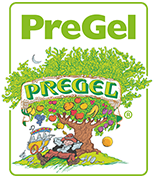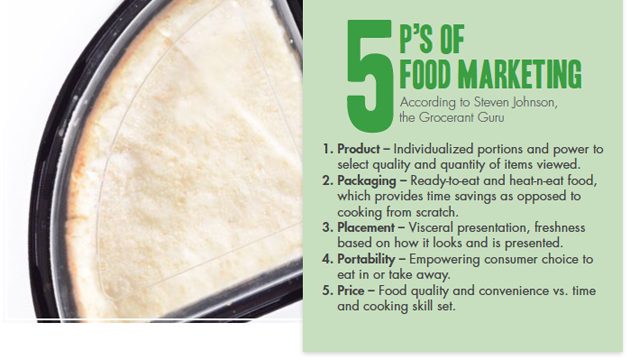Definition: A Grocery And Restaurant Merged Into One
What’s for dinner tonight? There are so many options to choose from: Chinese, Italian, Mexican, American, Greek, etc., and nowadays it can all be found under one roof along with fresh produce and your standard pharmaceutical needs. The modern day grocerant, a grocery and restaurant merged into one, offers both the consumer and retailer significant benefits spawned from one important element: convenience.
The grocerant is proving to be a valued resource for customizable meals that don’t require much time for today’s busy consumers to prepare, as they have little time to decipher what to cook for dinner, and even less time to shop for each ingredient. Steven Johnson, the “Grocerant Guru” and blogger behind www.grocerants.blogspot.com, describes grocerant fare as food items that are ready to eat or ready to heat. In grocery stores these items can be found in the deli/lifestyle section, or designated buffet or walk-up ordering area.
When did this concept begin?
Though grocerants have recently been garnering a great amount of attention, this concept is not as fresh as the produce just down the aisle. According to “Future Food: Gazing Into the Food Industry’s Crystal Ball Gives Hints About What’s Coming Next to Your Supermarket” posted in the Chicago Tribune, Boston Market started the trend in the late 1980s by offering whole chicken dinners with all the fixings as takeout food, then grocery stores began expanding the concept.
What food selections are generally available at the grocerant?
Basic selections include rotisserie and fried chicken; custom sushi stations; pre-made salads and salad bars; varying cold pasta, vegetable, grain, and potato salads; bake and eat, and prepared pizzas of all varieties; ready-to-eat and custom prepared sandwiches complete with various bread options; olive bars; soup offerings; and fresh breads. Grocerants also offer a savory array of heat-and-eat side dishes. More upscale piquant options are also beginning to emerge such as crab cakes, beef burgundy, kung pao scallops and cedar-plank salmon. Asian bars, and prepare-to-order pasta bars are grocerant value-adds.
For dessert lovers, sweet possibilities abound as well. Decadent cakes of varying flavors; a wide range of cookies; mousses; puddings; verrines; muffins and donuts; and even fresh soft serve frozen dessert are among the many indulgent choices consumers can select from.
What influenced grocers to enhance their format?
Consumer trends tend to change consistently and rapidly, causing retailers to compete for customer attention and loyalty. This is also the case with grocery outlets. As the economic shift happened during the earlier part of the 21st Century, consumers began to focus more of their finances toward dining at home rather than eating at restaurants. This caused supermarkets to quickly offer more diverse, ready-to-eat selections, competitive pricing and one-stop-shop positioning.
In many cases, grocers altered their deli service models and renovated stores to reflect their new focus on consumers claiming neither the time nor interest to cook, as consumer-friendly boutique-style upgrades are a proven traffic and profits booster.
What makes grocerants so successful?
A bevy of reasons have bolstered and maintained the success of the grocerant concept based around time-starved consumers. According to Technomic, a marketing research firm, offering restaurant quality at home; restaurant dining in-store; convenience without sacrifice of time or the chore of cooking; and health-conscious prepared food options that are “better for you without effort” are all services that have made it easier for customers to continue eating at home as opposed to going out.
According to Johnson, the 5 P’s of food marketing, a format which most grocery stores follow, also drive sales:
- Product – Individualized portions and power to select quality and quantity of items viewed.
- Packaging – Ready-to-eat and heat-n-eat food, which provides time saving as opposed to cooking from scratch.
- Placement – Visceral presentation, freshness based on how it looks and is presented.
- Portability – Empowering consumer choice to eat in or take away.Price – Food quality and convenience vs. time and cooking skill set.
- Price – Food quality and convenience vs. time and cooking skill set.
What is the bottom line?
The evolution of groceries to grocerants has not only provided more food options, meal bundles and convenience, but has additionally driven up top line sales and bottom line profits within existing points of fresh food distribution, garnering share from legacy food retailers, says Johnson.
Evolution in business is crucial to continued growth, so it is imperative to always consider change and stay ahead of current trends. For instance, remaining abreast of the latest trends in ethnic ingredients and cuisine is important, as international flavors are one of today’s hottest food topics. Some of the top retail grocers also incorporate organic foods and in-store cooking classes to provide a more unique experience. Wine and beer bars are another frontier grocerants are adding to provide a better-rounded takeaway meal. Innovating new and creative meals that incorporate the latest trends in cuisine helps promote customer interest, brand loyalty and repeat traffic. In the case of grocerants, opportunities are huge for share of market.
Resources and Further Reads:
Celentano, D. (2012). Consumers Don’t Cook From Scratch…They Go to Grocerants. About.com Food & Beverage. Retrieved February 2013 http://foodbeverage.about.com/od/Grocerant/g/Consumers-Don-TCook-From-Scratch-They-Go-To-Grocerantss.htm.
Smith, D. (2012). The Ultimate Food Fight: Are You Losing Business to the Grocery Down the Street? Don’t Worry. You’re not alone. Retrieved February 2013 http://www.qsrmagazine.com/competition/ultimatefood-fight.
Anderson, E. (1998). Future Food: Gazing Into The Crystal Ball Gives Hints About What’s Coming Next To Your Supermarket. Retrieved February 2013 http://articles.chicagotribune.com/1998-10-14/entertainment/9810220006_1_dietary-fiber-food-processing-future-food/2
Johnson, S. (2010). Technomic Focuses in on the Grocerant Niche; It’s Booming and Competition is Heating Up! Retrieved February 2013 http://grocerants.blogspot.com/search?updated-min=2010-01-01T00:00:00-08:00&updated-max=2011-01-01T00:00:00-08:00&max-results=50.
Johnson, S. (2013). Top 5 Reasons Ready-2-Eat and Heat-Neat Grocerant Food is Booming.Grocerant Guru:www.grocerants. blogspot.com Retrieved February 2013 http://grocerants.blogspot.com/2013/02/top-5-reasons-ready-2-eat-and-heat-neat.html.

